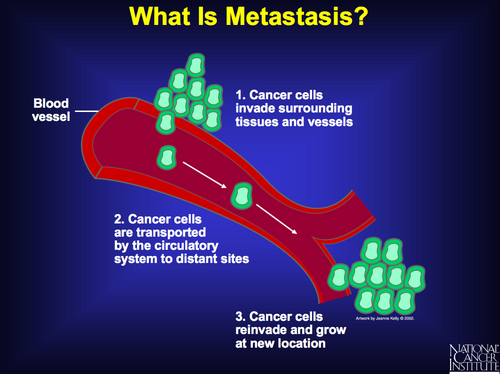



Metastases and invasion: the 6th and most unique of the hallmarks of cancer

Tissue invasion is extension from the primary organ beyond adjacent tissue into the next organ; for example, from the lung through the pleura into bone or nerve.
The capacity to metastasize is a highly lethal - most cancer fatalities are due to metastasis.
The last of these six capabilities, tissue invasion and metastasis, is the most heterogeneous and poorly understood.
Distant metastases are tumour cells that have broken away from the primary tumour, have traveled to other parts of the body, and have begun to grow at the new location.
Distant stage is also called remote, diffuse, disseminated, metastatic, or secondary disease. In most cases there is not a continuous trail of tumour cells between the primary site and the distant site.
Mechanisms of Metastasis
1- Lymph channel spread
Travel in lymph channels beyond the first (regional) drainage area to lymph nodes that are considered remote from the primary site.
Tumor cells can be filtered, trapped and begin to grow in any lymph nodes in the body
2- Hematogenous or blood-borne metastases
Invasion of blood vessels within the primary tumor allows escape of tumor cells or tumor emboli which are transported through the blood stream to another part of the body where it lodges in a capillary or arteriole.
At that point the tumor penetrates the vessel wall and grows into the surrounding tissue
3-Spread through fluids in a body cavity
Example: malignant cells rupture the surface of the primary tumor and are released into the thoracic or peritoneal cavity.
They float in the fluid and begin to grow on any tissue reached by the fluid. This type of spread is also called implantation or seeding metastases.
Metastases and invasion: role of genes
It is becoming clear that specific gene products are associated with the ability of tumor cells to metastasize to different organ sites.
Elegant animal metastasis models, as well as transcriptional profiling of human cancers, are revealing that metastasis includes alterations in genes involved in processes such as cell adhesion, integrin signaling, growth factors, chemokine signal transduction, and extracellular proteolysis
 Previous
Previous